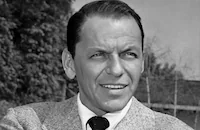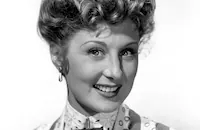On the Town

Brief Synopsis
Cast & Crew
Gene Kelly
Gene Kelly
Frank Sinatra
Betty Garrett
Ann Miller
Jules Munshin
Film Details
Technical Specs

Synopsis
Chip, Gabey and Ozzie, three sailors on a twenty-four hour shore leave, look for adventure and romance in New York City and seek out the city's best known attractions. Following a whirlwind tour of Manhattan that includes stops at the Empire State Building, Central Park and Rockefeller Center, Ozzie and Gabey decide to forgo sightseeing and instead pursue the beautiful women of New York. While riding on a subway, the three sailors see a poster of Ivy Smith, "Miss Turnstiles" for the month of June, and fall instantly in love with her. As they gaze dreamily at the poster, they imagine Ivy coming to life and revealing her life story in a dance. Although they all are taken with her beauty, Gabey is especially smitten with Ivy and vows to find her. To their astonishment, the sailors find Ivy as soon as they step off the train into the subway station, whiere Ivy is posing for a photo shoot. Gabey poses with her for a photograph, but before he can make an impression on her, she disappears. Gabey, Chip and Ozzie follow Ivy and pile into a taxicab driven by the flirtatious Brunhilde Esterhazy, who tries to seduce Chip. With the facts on the poster about Ivy's life as their only clues to her whereabouts, Gabey and his pals search for her in places she is likely to be found. Accompanied by Brunhilde, who is determined to snare Chip, the sailors look for Ivy at the Museum of Natural History, where Ozzie meets Claire Huddeson, an anthropologist who quickly succumbs to his charms. While celebrating their new love with a kiss and a dance, Ozzie and Claire accidentally destroy a dinosaur skeleton at the museum. They flee, but the police are on their trail. The search for Ivy continues at various museums around the city. Finally the group decides to split up and search for her separately, agreeing to meet at 8:30 that evening at the Empire State Building. Alone at last with Chip, Brunhilde takes him to her apartment, only to be greeted by her annoying, ailing roommate, Lucy Shmeeler. Meanwhile, Gabey finds Ivy in a dance studio, and she consents to go on a date with him that evening. As she owes her dance instructor, the unpleasant, dipsomaniacal Madame Dilyovska, a great deal of money, Ivy promises to return from her date at 11:30, in time to make her performance as a cooch dancer at Coney Island. At 8:30, Chip, Brunhilde, Ozzie, Claire and Gabey meet at the top of the Empire State Building, where they hide Ozzie from the policemen who are looking for him. When Ivy arrives, the three couples begin their wild night on the town. The merriment soon comes to an end, however, when, at 11:30, Ivy vanishes without explanation, leaving behind only a brief farewell note. Although his pals try to cheer him up by quickly substituting Lucy for Ivy, Gabey gets drunk and sadly recalls his time with Ivy. Later, acting on a tip from Madame Dilyovska, Gabey and his pals find Ivy at Coney Island, where she admits that shame made her keep her job a secret from him. Gabey and Ivy soon resume their romance, but they only have a few hours remaining before the end of Gabey's shore leave. After Ivy, Claire and Brunhilde persuade the police to drop the charges against the men, the three women bid their sailors farewell at the shipyard.

Cast

Gene Kelly

Frank Sinatra

Betty Garrett

Ann Miller

Jules Munshin

Vera-ellen

Florence Bates
Alice Pearce
George Meader
Murray Alper
Tom Dugan
Robert B. Williams
William "bill" Phillips
Dick Wessel
Bea Benaderet
Gladys Blake
Milton Kibbee
Jack Shea
Don Brodie
Jed Dooley

Sid Melton
Eugene Borden

Hans Conreid
Peter Chong
Royal Raymond
Helen Mcallister
Lew Smith
Lennie Bremen
Jack Lee

Bud Wolfe
Frank Hagney
Richard Kean
Gloria Marlen
Dorinda Clifton
Diane Nance
Helen Eby-rock
Tim Hawkins
Norman Ollestad
Curtis Jackson
Carol Haney
Wanda Flippen
Ann Beck
Lester Dorr
Bob Stevenson
Claire Carleton
Bette Arlen
Pamela Vickers
Kerry O'day
Crew
Jack Aldworth
Leonard Bernstein
Hugh Boswell
Saul Chaplin
Betty Comden
Betty Comden
Jack Dawn
Roger Edens
Roger Edens
Arthur Freed
Jack Gertsman
Cedric Gibbons
James Gooch
Adolph Green
Adolph Green
Sydney Guilaroff
Lennie Hayton
Judy Holliday
Lloyd Isbell
Henri Jaffa
Robert Martin
Jack D. Moore
Warren Newcombe
Helen Rose
Harold Rosson
Conrad Salinger
Douglas Shearer
Frank Shugrue
Lela Simone
Jack Martin Smith
Harry Stradling
John A. Williams
Edwin B. Willis
Ralph E. Winters

Photo Collections
Videos
Movie Clip




Trailer
Hosted Intro








Film Details
Technical Specs

Award Wins
Best Score
Articles
On the Town
On the Town (1949) is undoubtedly one of the key works in the development of the Hollywood musical. Up to that time, musicals were entirely studio-bound, with rare exceptions such as the Brooklyn Bridge sequence in It Happened in Brooklyn (1947). Directors Stanley Donen and Gene Kelly wanted to use extensive locations, but the studio allowed only one week of shooting in New York. It proceeded at a breathless pace, often using hidden cameras to avoid crowd problems. Another innovative feature, also part of the Broadway stage production, is their use of modern dance to advance the plot in sequences such as "Miss Turnstiles" and "A Day in New York." Kelly's interest in using modern dance would develop further in the climactic ballet of An American in Paris (1951) and Invitation to the Dance (1956).
In fact, the two aforementioned dance numbers, along with the songs "New York, New York" and "Come Up to My Place," were the only musical numbers retained for Bernstein's original score. Betty Comden and Adolph Green, who wrote the book and played Claire and Ozzie in the Broadway production, were hired by MGM to write new lyrics. Roger Edens composed six new songs, receiving an Academy Award (along with Musical Director Lennie Hayton) in the process. The Breen office forbade the use of "helluva" in the song "New York, New York," which MGM eventually changed to "wonderful." Alice Pearce was the sole holdover from the Broadway cast. Produced for $2,100,00, On the Town grossed over $4,400,000, reflecting the continuing profitability of the musical genre at that time.
Sinatra, who was 34, resented having to wear hairpieces and special padding in the buttocks to fill out the sailor outfit. After playing a sailor previously in Anchors Aweigh (1945), also starring Gene Kelly, he is said to have vowed never to wear such an outfit again; we should be thankful that he changed his mind. It's Always Fair Weather (1955), a later Kelly/Donen effort, was intended as a sequel to On the Town, but Sinatra and Munshin weren't available for the production.
For the record, Sinatra gets to sing on five numbers in On the Town and they include the two previously mentioned songs - "New York, New York" and "Come Up to My Place" - as well as "You're Awful," "Count on Me," and the title song.
Director: Gene Kelly and Stanley Donen
Producer: Arthur Freed
Screenplay: Betty Comden and Adolph Green
Cinematography: Harold Rosson
Editing: Ralph E. Winters
Music: Roger Edens and Leonard Bernstein
Principle Cast: Gene Kelly (Gabey), Frank Sinatra (Chip), Jules Munshin (Ozzie), Vera-Ellen (Ivy Smith), Betty Garrett (Brunhilde Esterhazy), Ann Miller (Claire Huddesen), Alice Pearce (Lucy Schmeeler).
C-98m. Close captioning. Descriptive video.
by James Steffen

On the Town
Quotes
Trivia
In her screen debut, Alice Pearce repeated her role from the 1944 Broadway musical.
Jules Munshin (I) had a fear of heights. During the "New York, New York" number on the top of the skyscraper he's always holding on to the wall or one of the other two.
First musical feature film to be shot on location
The crew tried to keep the location filming in New York City as low key as possible. Many of the scenes were filmed from the back of a station wagon. At the end of "New York, New York", as the camera tilts up at Rockefeller Plaza, you can see the skating rink lined with spectators watching Frank Sinatra and 'Gene Kelly' .
When 'Gene Kelly' dismisses the beauty of a passing New York gal, 'Jules Munshin (I)' asks, "Who you got waiting for you in New York, Ava Gardner?" Frank Sinatra was having an affair with Gardner at the time.
Notes
The stage musical On the Town was based on the Jerome Robbins ballet entitled Fancy Free, which opened at the Ballet Theatre in New York in the spring of 1944. In addition to writing the book for the stage version of On the Town and writing the screenplay for the film, Betty Comden and Adolph Green appeared in the stage version in the roles of "Claire" and "Ozzie." News items in Hollywood Reporter in 1945 note that M-G-M purchased the rights to the musical (before it opened) for $250,000, and that $65,000 of that sum was used to finance the Broadway run of the show. A biography of producer Arthur Freed notes the following information regarding the development of the film: Before purchasing the film rights to the musical, M-G-M had assigned George Abbott, the director of the stage show, to direct the film version. According to the Freed biography, Louis B. Mayer and other studio executives disliked the stage show when they saw it and regretted their involvement in the property. By November 1945, the studio had assigned Gene Kelly and Stanley Donen to direct the film, and contracted Comden and Green to rewrite the book with much of Bernstein's original score discarded. The film features only four songs from the original musical, those composed by Leonard Bernstein, and six that were created especially for the screen. According to information contained in the file on the film in the MPAA/PCA Collection at the AMPAS Library, the Breen Office refused to allow the use of the word "helluva" in the song "New York, New York [it's a helluva town]." M-G-M later changed the word to "wonderful." The biography of Freed lists Andrew Marton as the second unit director and Charles Schoenbaum as the second unit photographer. Hollywood Reporter production charts list Clinton Sundberg in the cast, but he did not appear in the released film. A May 1949 Hollywood Reporter news item lists actress Irene Rohan in the cast, but her appearance in the final film has not been confirmed.
According to a June 1949 Hollywood Reporter news item, cameraman Harry Stradling worked on the film briefly, shooting one of the last musical sequences for the film. Various Hollywood Reporter news items indicate that nine days of filming took place at many locations in New York City, including the Brooklyn Navy Yard, Wall Street, the Statue of Liberty, Central Park and Fifth Avenue. The location shooting marked the first time a major studio dispatched a company to film musical numbers in public areas of New York City. Modern sources note that the final cost of the film was $2,100,000, and that is grossed in excess of $4,440,000. Roger Edens and Lennie Hayton received an Academy Award for the film's musical score. On the Town marked the screen debut of actresses Carol Haney and Bea Benaderet.

Miscellaneous Notes
Released in United States 1997
Released in United States 1998
Released in United States December 30, 1949
Released in United States Winter January 1, 1949
Released in USA on video.
Released in United States 1997 (Shown in Los Angeles (Laemmle) as part of program "Makes Great Musicals: A Salute to MGM's Legendary Freed Unit" September 6 - December 21, 1997.)
Released in United States 1998 (Shown in New York City (Walter Reade) as part of program "A Salute to Sinatra" August 21 - September 8, 1998.)
Released in United States Winter January 1, 1949
Released in United States December 30, 1949















